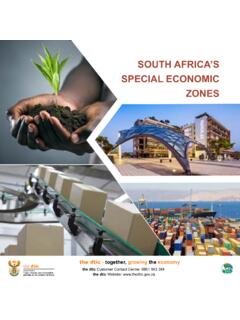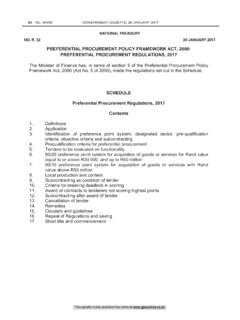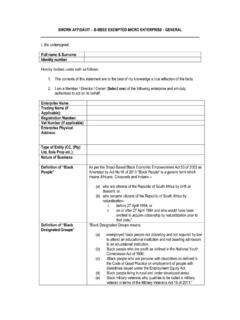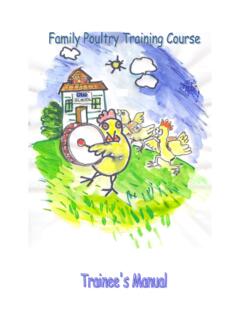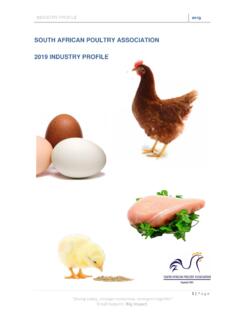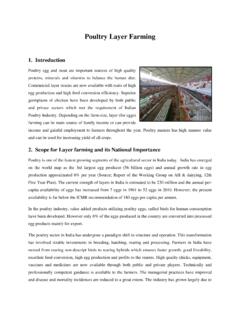Transcription of The South African Poultry
1 The South AfricanPoultrySectorMaster Plan November 2019the dtic - together, growing the economythe dtic Customer Contact Centre: 0861 843 384 the dtic Website: , Industry and Competition Department:REPUBLIC OF South AFRICAthe dticContents1. Introduction ..22. Overview and background analysis ..43. Strategic objectives ..64. Required actions ..85. Support for the Poultry Master .. 15 Acronyms used in this reportAfCFTAA frican Continental Free Trade AreaAgriSETAA gricultural Sector Education Training AuthorityAMIEA ssociation of Meat Importers and ExportersBEEB lack Economic Empowerment DALRRDD epartment of Agriculture, Land Reform and Rural Development DOHD epartment of Healththe dticDepartment of Trade.
2 Industry and CompetitionEBIESA Emerging Black Importers and Exporters of South Africa EUEuropean UnionFAWU Food and Allied Workers Union FoodBev SETAThe Food and Beverage Manufacturing Sector Education Training Authority IDCI ndustrial Development CorporationITACI nternational Trade Administration Commission MDMM echanically Deboned MeatSASouth AfricaSABSS outh African Bureau of StandardsSADCS outhern African Development Community SAPASA Poultry AssociationSARSS outh African Revenue ServiceSPSS anitary and Phyto-SanitaryStats SAStatistics South AfricaTIPST rade and Industry Policy Secretariat The Department of Trade, Industry and Competition (the dtic), November 2019 Photos are royalty-free stock images, courtesy of the dtic photo dtic Campus77 Meintjies StreetSunnysidePretoria0002the dticPrivate Bag X84 Pretoria0001the dtic customer contact centre: 0861 843 384the dtic website.
3 Poultry Sector Master Plan has been developed in a close partnership between Government and a number of stakeholders in the industry, drawn from Poultry farmers, processors, exporters, importers and organised labour. It provides a framework for a determined effort to grow the output (and jobs) in the industry through a number of measures that will be implemented over a number of years. Significantly, it sets out a new, joint vision across the value-chain, identifies five pillars that underpin the vision and creates a Poultry Sector Master Plan Council to monitor and drive implementation of the pillars.
4 The parties that contributed to the Master Plan include: The Ministries of Trade, Industry and Competition as well as Agriculture, Land Reform and Rural Development (DALRRD) Local Poultry producers, through the SA Poultry Association (SAPA) as well as a number of independent producers, including Poultry farmers who are contracted to large integrated producers as well as independent producers Poultry traders, represented by their industry bodies, the Association of Meat Importers and Exporters (AMIE)
5 And Emerging Black Importers and Exporters of South Africa (EBIESA) Organised labour, through the Food and Allied Workers Union (FAWU) Other interested parties including the South African Association of Meat Processors Government entities, through the Department of Trade, Industry and Competition (the dtic); the Department of Agriculture, Land Reform and Rural Development; the Department of Health; the Trade and Industry Policy Secretariat (TIPS), the Industrial Development Corporation (IDC); the Land Bank; and the International Trade Administration Commission (ITAC).
6 Each constituency recognises the need for it to contribute practically to building a strong and competitive industry, and the Master Plan sets out the commitments by the parties. Introduction123 The Poultry sector plays a key role in South African life: It provides an important, affordable source of protein for millions of households, and is a staple of the South African dinner table It is a pillar of the South African agricultural economy, adding value to our maize and soya crops, and serving as a key customer of the farming sector, including a significant number of emerging farmers Barriers to entry are reasonably low.
7 Allowing emerging farmers and small scale participants and local economies to supplement industrial scale activity Poultry is also an important sector of food processing, adding value and creating jobs throughout the length and breadth of the demand for Poultry products has grown substantially in the democratic era, partly reflecting higher incomes across the South African population. For the first 15 years of democracy, the production of Poultry also grew but this began to stagnate around 2008.
8 Production has been static for the last decade despite the fact that consumption has continued to grow. This has happened because imported Poultry has come into the economy in large quantities, displacing South African meat especially at the lower end. Tariffs were increased substantially in 2013, but this has not arrested the growth in imports. Some of our large Poultry production companies are regarded as highly efficient in their production systems. Despite this we have been unable to compete effectively with imports especially at the lower end of the price range, and we have failed to grow exports.
9 Overview and background analysis2 Figure 2: SA Poultry Imports, 2013-2018 (tons)Figure 1: SA Poultry Production, Consumption and Imports, 2011-2018 (tons)0500 0001 000 0001 500 0002 000 0002 500 0002011 ProductionImportsConsumption201220132014 20152016201720180200 000300 000400 000500 000600 0002013 Total Poultry importsChicken meat excl MDM20142015201620172018 MDMBone in portionsBoneless cutsWhole bird100 000 Figure 1 demonstrates clearly that: Consumption of chicken meat in South Africa has grown substantially although more slowly after 2008 Production has stagnated as imports have risen, with imports having risen fourfold over 20 years.
10 The potential growth in local production has therefore been displaced by imports. This has mainly been due to the lower prices at which imports have come into our market. Market conditions and trade agreements have brought significant quantities of low-priced chicken products into our market. These have put pressure on local prices and reduced the market share of South African producers. While there may have been benefit for consumers, we have been unable to drive growth in the industry. At the same time we have been unable to make up the differential through exports.
